Depression and post‐traumatic stress
VerifiedAdded on 2022/09/14
|11
|3787
|12
AI Summary
Contribute Materials
Your contribution can guide someone’s learning journey. Share your
documents today.
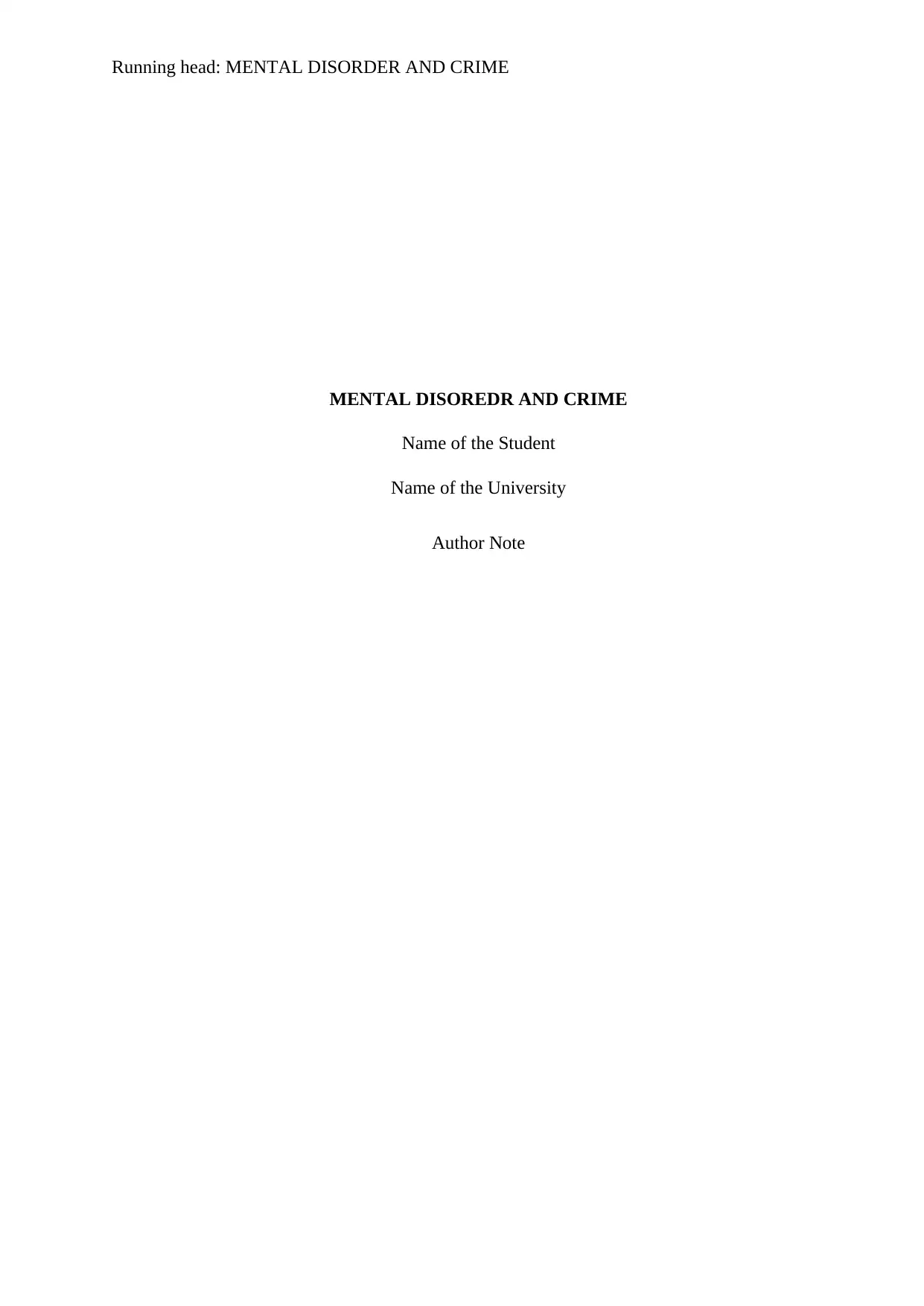
Running head: MENTAL DISORDER AND CRIME
MENTAL DISOREDR AND CRIME
Name of the Student
Name of the University
Author Note
MENTAL DISOREDR AND CRIME
Name of the Student
Name of the University
Author Note
Secure Best Marks with AI Grader
Need help grading? Try our AI Grader for instant feedback on your assignments.

1
MENTAL DISOREDR AND CRIME
The primary aim of the essay is to examine how socio-emotional factors leads to
mental disorder that ultimately results in committing crimes. It is essential to note that all
people suffering from mental disorder are not violent and most violent people do not suffer
from mental disorder. The essay is aimed at contributing as well as expanding the body of
knowledge about crime as well as mental disorder and at the same time link the association
between mental disorder and crime with some psychological theories that will help the
readers to understand the topic in a comprehensible manner (Auerbach et al., 2016). Next the
essay will discuss about some evidence based research that will help in understanding the link
between mental disorder and crime. The essay will further discuss about some mental health
problems that might lead to crime. The essay will not focus on only one type of mental health
disorder that leads to crime but a number of examples will be cited for a better understanding
of the argument.
Special relationship is a term that is used to explain the link between two contrary or
similar aspects that is both strong as well as essential. It clearly states the relationship
between two things that makes it easier for the readers to understand. Mental illness most
commonly known as mental health disorders refers to a number of mental health conditions
that affects the mood of a person, his/her thinking as well as behaviour (Priester et al., 2016).
Some common examples of mental health disorders include depression, anxiety, anxiety
disorder, additive behaviour and others. Mental health disorder can take place due to a
number of reasons such as severe psychological trauma that a person might experience during
his/her childhood (Priester et al., 2016). The trauma can be emotional, physical as well as
sexual abuse. Mental health disorder can also occur when the child is neglected at an early
stage of his life or when he experiences violence around him due to an abusive father or a
drug addict mother. Social isolation as well as loneliness to can lead to mental problems
(Mulder et al., 2018). Social problems such as poverty, discrimination, stigma debt are also
MENTAL DISOREDR AND CRIME
The primary aim of the essay is to examine how socio-emotional factors leads to
mental disorder that ultimately results in committing crimes. It is essential to note that all
people suffering from mental disorder are not violent and most violent people do not suffer
from mental disorder. The essay is aimed at contributing as well as expanding the body of
knowledge about crime as well as mental disorder and at the same time link the association
between mental disorder and crime with some psychological theories that will help the
readers to understand the topic in a comprehensible manner (Auerbach et al., 2016). Next the
essay will discuss about some evidence based research that will help in understanding the link
between mental disorder and crime. The essay will further discuss about some mental health
problems that might lead to crime. The essay will not focus on only one type of mental health
disorder that leads to crime but a number of examples will be cited for a better understanding
of the argument.
Special relationship is a term that is used to explain the link between two contrary or
similar aspects that is both strong as well as essential. It clearly states the relationship
between two things that makes it easier for the readers to understand. Mental illness most
commonly known as mental health disorders refers to a number of mental health conditions
that affects the mood of a person, his/her thinking as well as behaviour (Priester et al., 2016).
Some common examples of mental health disorders include depression, anxiety, anxiety
disorder, additive behaviour and others. Mental health disorder can take place due to a
number of reasons such as severe psychological trauma that a person might experience during
his/her childhood (Priester et al., 2016). The trauma can be emotional, physical as well as
sexual abuse. Mental health disorder can also occur when the child is neglected at an early
stage of his life or when he experiences violence around him due to an abusive father or a
drug addict mother. Social isolation as well as loneliness to can lead to mental problems
(Mulder et al., 2018). Social problems such as poverty, discrimination, stigma debt are also
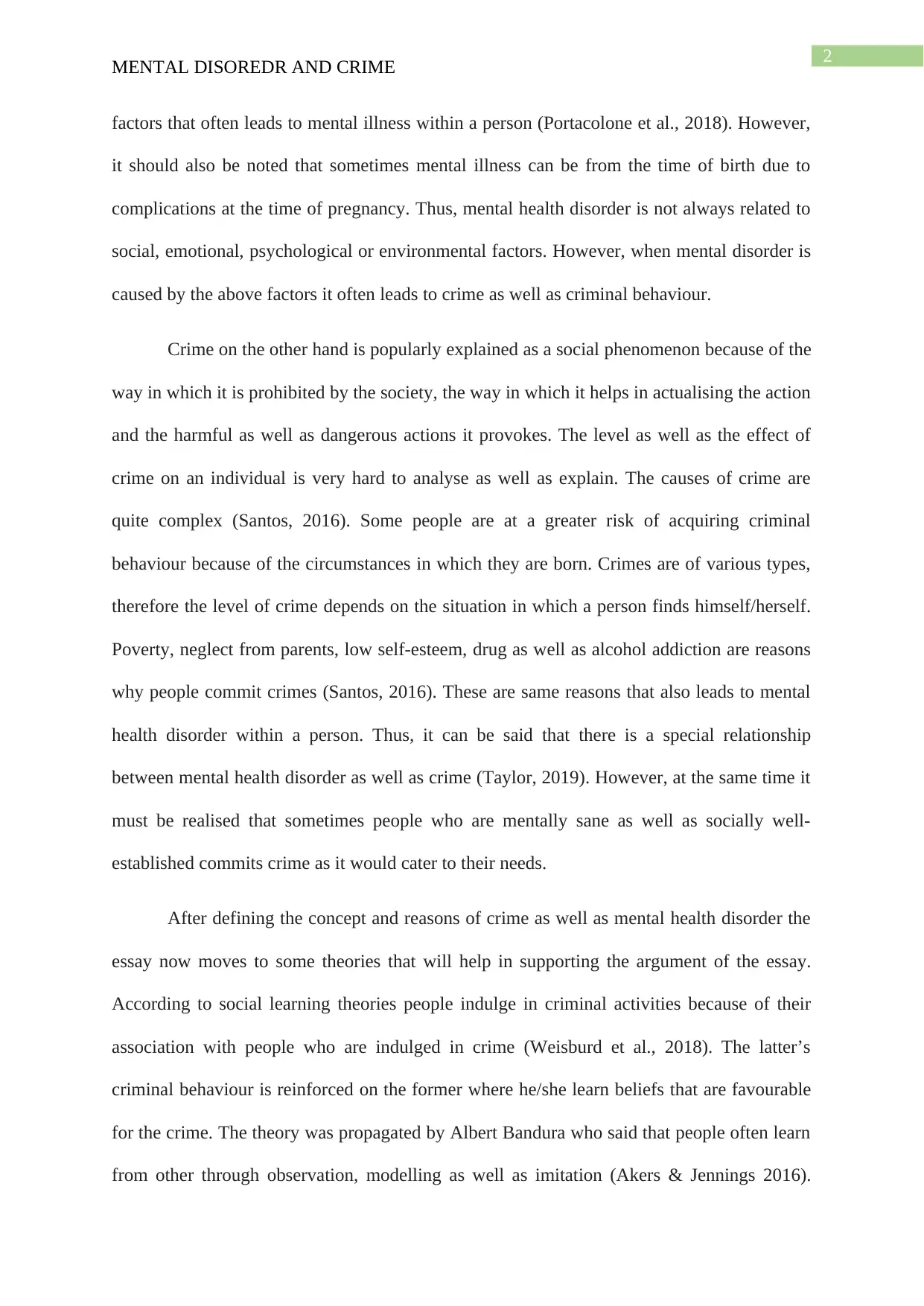
2
MENTAL DISOREDR AND CRIME
factors that often leads to mental illness within a person (Portacolone et al., 2018). However,
it should also be noted that sometimes mental illness can be from the time of birth due to
complications at the time of pregnancy. Thus, mental health disorder is not always related to
social, emotional, psychological or environmental factors. However, when mental disorder is
caused by the above factors it often leads to crime as well as criminal behaviour.
Crime on the other hand is popularly explained as a social phenomenon because of the
way in which it is prohibited by the society, the way in which it helps in actualising the action
and the harmful as well as dangerous actions it provokes. The level as well as the effect of
crime on an individual is very hard to analyse as well as explain. The causes of crime are
quite complex (Santos, 2016). Some people are at a greater risk of acquiring criminal
behaviour because of the circumstances in which they are born. Crimes are of various types,
therefore the level of crime depends on the situation in which a person finds himself/herself.
Poverty, neglect from parents, low self-esteem, drug as well as alcohol addiction are reasons
why people commit crimes (Santos, 2016). These are same reasons that also leads to mental
health disorder within a person. Thus, it can be said that there is a special relationship
between mental health disorder as well as crime (Taylor, 2019). However, at the same time it
must be realised that sometimes people who are mentally sane as well as socially well-
established commits crime as it would cater to their needs.
After defining the concept and reasons of crime as well as mental health disorder the
essay now moves to some theories that will help in supporting the argument of the essay.
According to social learning theories people indulge in criminal activities because of their
association with people who are indulged in crime (Weisburd et al., 2018). The latter’s
criminal behaviour is reinforced on the former where he/she learn beliefs that are favourable
for the crime. The theory was propagated by Albert Bandura who said that people often learn
from other through observation, modelling as well as imitation (Akers & Jennings 2016).
MENTAL DISOREDR AND CRIME
factors that often leads to mental illness within a person (Portacolone et al., 2018). However,
it should also be noted that sometimes mental illness can be from the time of birth due to
complications at the time of pregnancy. Thus, mental health disorder is not always related to
social, emotional, psychological or environmental factors. However, when mental disorder is
caused by the above factors it often leads to crime as well as criminal behaviour.
Crime on the other hand is popularly explained as a social phenomenon because of the
way in which it is prohibited by the society, the way in which it helps in actualising the action
and the harmful as well as dangerous actions it provokes. The level as well as the effect of
crime on an individual is very hard to analyse as well as explain. The causes of crime are
quite complex (Santos, 2016). Some people are at a greater risk of acquiring criminal
behaviour because of the circumstances in which they are born. Crimes are of various types,
therefore the level of crime depends on the situation in which a person finds himself/herself.
Poverty, neglect from parents, low self-esteem, drug as well as alcohol addiction are reasons
why people commit crimes (Santos, 2016). These are same reasons that also leads to mental
health disorder within a person. Thus, it can be said that there is a special relationship
between mental health disorder as well as crime (Taylor, 2019). However, at the same time it
must be realised that sometimes people who are mentally sane as well as socially well-
established commits crime as it would cater to their needs.
After defining the concept and reasons of crime as well as mental health disorder the
essay now moves to some theories that will help in supporting the argument of the essay.
According to social learning theories people indulge in criminal activities because of their
association with people who are indulged in crime (Weisburd et al., 2018). The latter’s
criminal behaviour is reinforced on the former where he/she learn beliefs that are favourable
for the crime. The theory was propagated by Albert Bandura who said that people often learn
from other through observation, modelling as well as imitation (Akers & Jennings 2016).
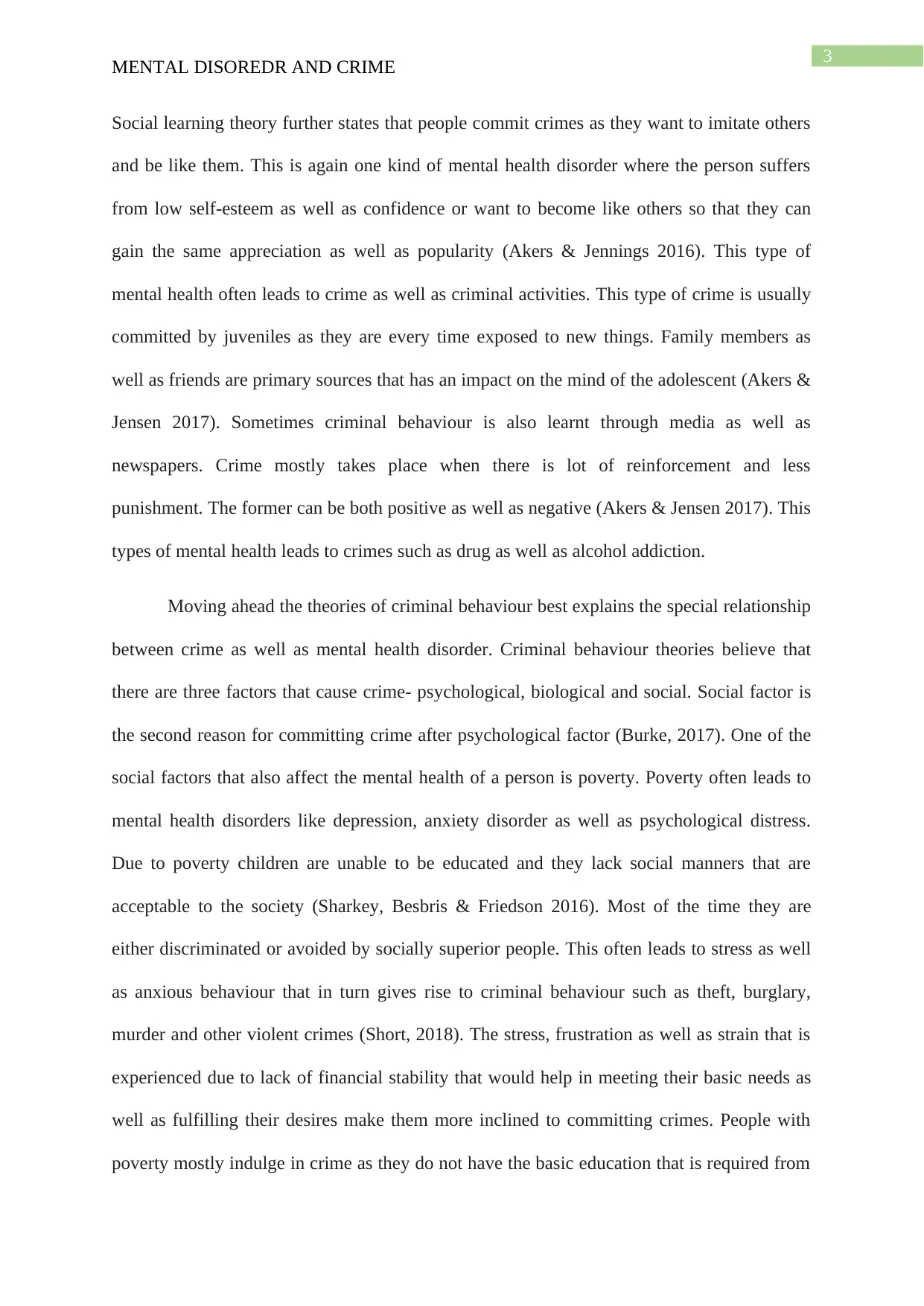
3
MENTAL DISOREDR AND CRIME
Social learning theory further states that people commit crimes as they want to imitate others
and be like them. This is again one kind of mental health disorder where the person suffers
from low self-esteem as well as confidence or want to become like others so that they can
gain the same appreciation as well as popularity (Akers & Jennings 2016). This type of
mental health often leads to crime as well as criminal activities. This type of crime is usually
committed by juveniles as they are every time exposed to new things. Family members as
well as friends are primary sources that has an impact on the mind of the adolescent (Akers &
Jensen 2017). Sometimes criminal behaviour is also learnt through media as well as
newspapers. Crime mostly takes place when there is lot of reinforcement and less
punishment. The former can be both positive as well as negative (Akers & Jensen 2017). This
types of mental health leads to crimes such as drug as well as alcohol addiction.
Moving ahead the theories of criminal behaviour best explains the special relationship
between crime as well as mental health disorder. Criminal behaviour theories believe that
there are three factors that cause crime- psychological, biological and social. Social factor is
the second reason for committing crime after psychological factor (Burke, 2017). One of the
social factors that also affect the mental health of a person is poverty. Poverty often leads to
mental health disorders like depression, anxiety disorder as well as psychological distress.
Due to poverty children are unable to be educated and they lack social manners that are
acceptable to the society (Sharkey, Besbris & Friedson 2016). Most of the time they are
either discriminated or avoided by socially superior people. This often leads to stress as well
as anxious behaviour that in turn gives rise to criminal behaviour such as theft, burglary,
murder and other violent crimes (Short, 2018). The stress, frustration as well as strain that is
experienced due to lack of financial stability that would help in meeting their basic needs as
well as fulfilling their desires make them more inclined to committing crimes. People with
poverty mostly indulge in crime as they do not have the basic education that is required from
MENTAL DISOREDR AND CRIME
Social learning theory further states that people commit crimes as they want to imitate others
and be like them. This is again one kind of mental health disorder where the person suffers
from low self-esteem as well as confidence or want to become like others so that they can
gain the same appreciation as well as popularity (Akers & Jennings 2016). This type of
mental health often leads to crime as well as criminal activities. This type of crime is usually
committed by juveniles as they are every time exposed to new things. Family members as
well as friends are primary sources that has an impact on the mind of the adolescent (Akers &
Jensen 2017). Sometimes criminal behaviour is also learnt through media as well as
newspapers. Crime mostly takes place when there is lot of reinforcement and less
punishment. The former can be both positive as well as negative (Akers & Jensen 2017). This
types of mental health leads to crimes such as drug as well as alcohol addiction.
Moving ahead the theories of criminal behaviour best explains the special relationship
between crime as well as mental health disorder. Criminal behaviour theories believe that
there are three factors that cause crime- psychological, biological and social. Social factor is
the second reason for committing crime after psychological factor (Burke, 2017). One of the
social factors that also affect the mental health of a person is poverty. Poverty often leads to
mental health disorders like depression, anxiety disorder as well as psychological distress.
Due to poverty children are unable to be educated and they lack social manners that are
acceptable to the society (Sharkey, Besbris & Friedson 2016). Most of the time they are
either discriminated or avoided by socially superior people. This often leads to stress as well
as anxious behaviour that in turn gives rise to criminal behaviour such as theft, burglary,
murder and other violent crimes (Short, 2018). The stress, frustration as well as strain that is
experienced due to lack of financial stability that would help in meeting their basic needs as
well as fulfilling their desires make them more inclined to committing crimes. People with
poverty mostly indulge in crime as they do not have the basic education that is required from
Secure Best Marks with AI Grader
Need help grading? Try our AI Grader for instant feedback on your assignments.
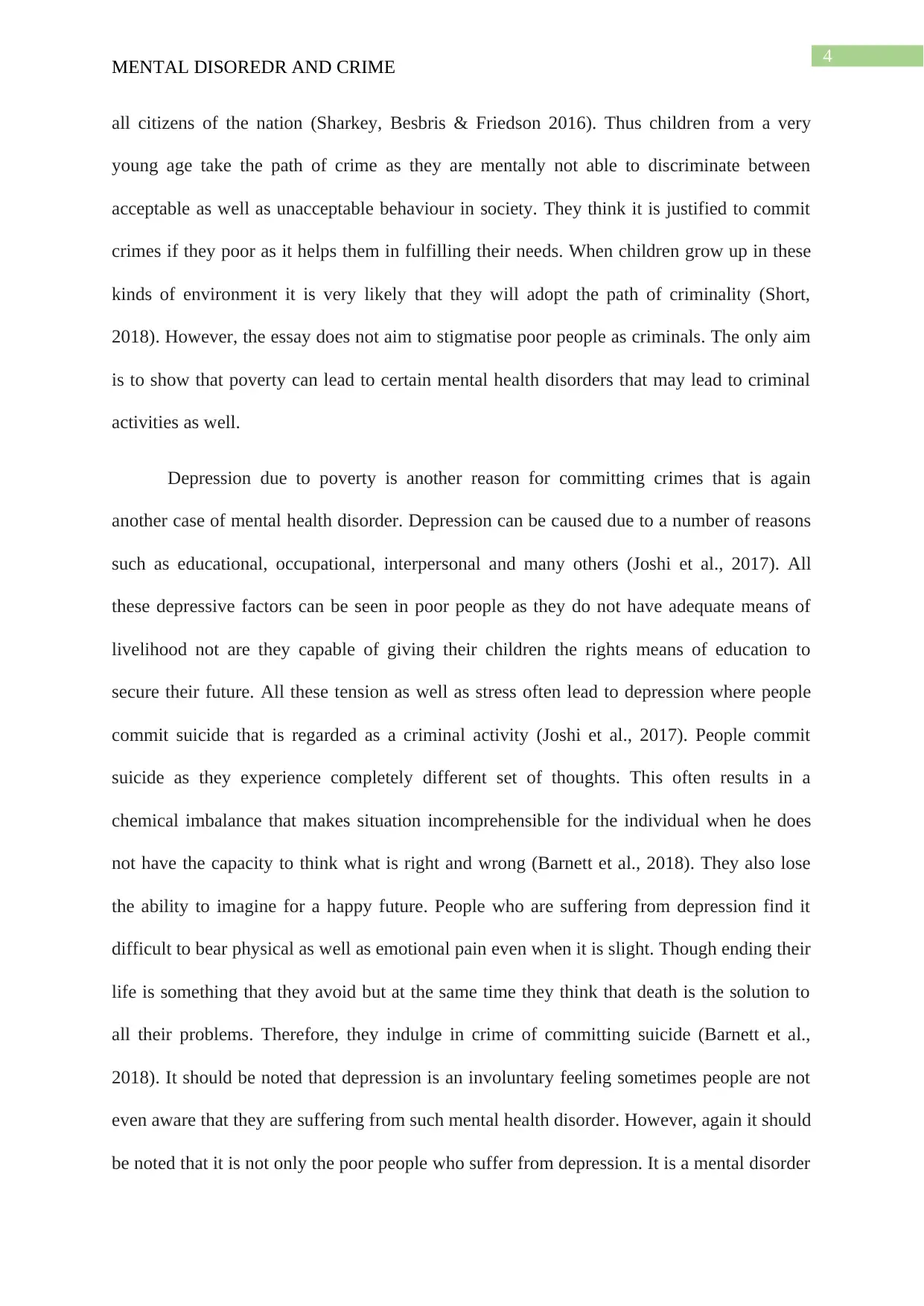
4
MENTAL DISOREDR AND CRIME
all citizens of the nation (Sharkey, Besbris & Friedson 2016). Thus children from a very
young age take the path of crime as they are mentally not able to discriminate between
acceptable as well as unacceptable behaviour in society. They think it is justified to commit
crimes if they poor as it helps them in fulfilling their needs. When children grow up in these
kinds of environment it is very likely that they will adopt the path of criminality (Short,
2018). However, the essay does not aim to stigmatise poor people as criminals. The only aim
is to show that poverty can lead to certain mental health disorders that may lead to criminal
activities as well.
Depression due to poverty is another reason for committing crimes that is again
another case of mental health disorder. Depression can be caused due to a number of reasons
such as educational, occupational, interpersonal and many others (Joshi et al., 2017). All
these depressive factors can be seen in poor people as they do not have adequate means of
livelihood not are they capable of giving their children the rights means of education to
secure their future. All these tension as well as stress often lead to depression where people
commit suicide that is regarded as a criminal activity (Joshi et al., 2017). People commit
suicide as they experience completely different set of thoughts. This often results in a
chemical imbalance that makes situation incomprehensible for the individual when he does
not have the capacity to think what is right and wrong (Barnett et al., 2018). They also lose
the ability to imagine for a happy future. People who are suffering from depression find it
difficult to bear physical as well as emotional pain even when it is slight. Though ending their
life is something that they avoid but at the same time they think that death is the solution to
all their problems. Therefore, they indulge in crime of committing suicide (Barnett et al.,
2018). It should be noted that depression is an involuntary feeling sometimes people are not
even aware that they are suffering from such mental health disorder. However, again it should
be noted that it is not only the poor people who suffer from depression. It is a mental disorder
MENTAL DISOREDR AND CRIME
all citizens of the nation (Sharkey, Besbris & Friedson 2016). Thus children from a very
young age take the path of crime as they are mentally not able to discriminate between
acceptable as well as unacceptable behaviour in society. They think it is justified to commit
crimes if they poor as it helps them in fulfilling their needs. When children grow up in these
kinds of environment it is very likely that they will adopt the path of criminality (Short,
2018). However, the essay does not aim to stigmatise poor people as criminals. The only aim
is to show that poverty can lead to certain mental health disorders that may lead to criminal
activities as well.
Depression due to poverty is another reason for committing crimes that is again
another case of mental health disorder. Depression can be caused due to a number of reasons
such as educational, occupational, interpersonal and many others (Joshi et al., 2017). All
these depressive factors can be seen in poor people as they do not have adequate means of
livelihood not are they capable of giving their children the rights means of education to
secure their future. All these tension as well as stress often lead to depression where people
commit suicide that is regarded as a criminal activity (Joshi et al., 2017). People commit
suicide as they experience completely different set of thoughts. This often results in a
chemical imbalance that makes situation incomprehensible for the individual when he does
not have the capacity to think what is right and wrong (Barnett et al., 2018). They also lose
the ability to imagine for a happy future. People who are suffering from depression find it
difficult to bear physical as well as emotional pain even when it is slight. Though ending their
life is something that they avoid but at the same time they think that death is the solution to
all their problems. Therefore, they indulge in crime of committing suicide (Barnett et al.,
2018). It should be noted that depression is an involuntary feeling sometimes people are not
even aware that they are suffering from such mental health disorder. However, again it should
be noted that it is not only the poor people who suffer from depression. It is a mental disorder
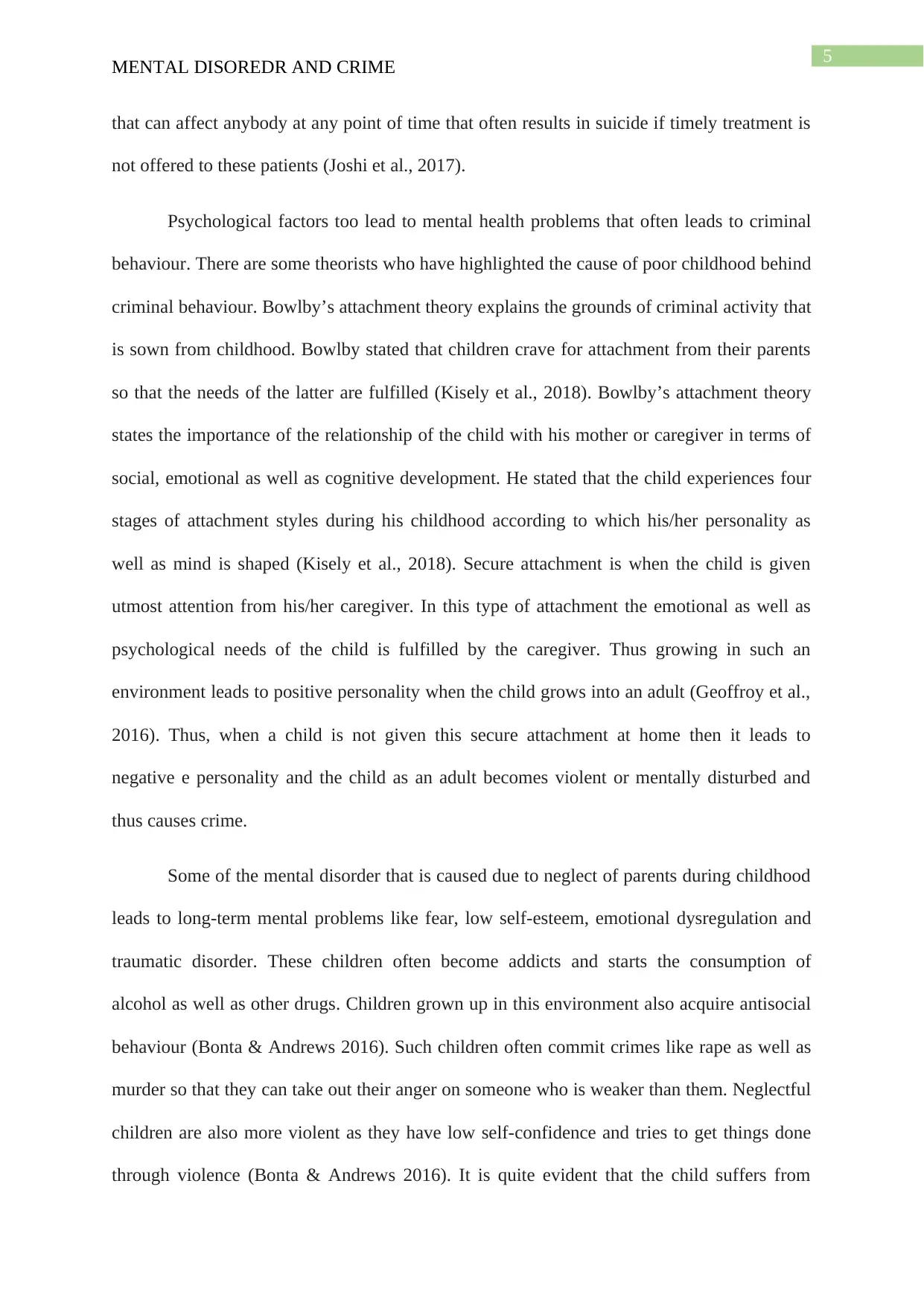
5
MENTAL DISOREDR AND CRIME
that can affect anybody at any point of time that often results in suicide if timely treatment is
not offered to these patients (Joshi et al., 2017).
Psychological factors too lead to mental health problems that often leads to criminal
behaviour. There are some theorists who have highlighted the cause of poor childhood behind
criminal behaviour. Bowlby’s attachment theory explains the grounds of criminal activity that
is sown from childhood. Bowlby stated that children crave for attachment from their parents
so that the needs of the latter are fulfilled (Kisely et al., 2018). Bowlby’s attachment theory
states the importance of the relationship of the child with his mother or caregiver in terms of
social, emotional as well as cognitive development. He stated that the child experiences four
stages of attachment styles during his childhood according to which his/her personality as
well as mind is shaped (Kisely et al., 2018). Secure attachment is when the child is given
utmost attention from his/her caregiver. In this type of attachment the emotional as well as
psychological needs of the child is fulfilled by the caregiver. Thus growing in such an
environment leads to positive personality when the child grows into an adult (Geoffroy et al.,
2016). Thus, when a child is not given this secure attachment at home then it leads to
negative e personality and the child as an adult becomes violent or mentally disturbed and
thus causes crime.
Some of the mental disorder that is caused due to neglect of parents during childhood
leads to long-term mental problems like fear, low self-esteem, emotional dysregulation and
traumatic disorder. These children often become addicts and starts the consumption of
alcohol as well as other drugs. Children grown up in this environment also acquire antisocial
behaviour (Bonta & Andrews 2016). Such children often commit crimes like rape as well as
murder so that they can take out their anger on someone who is weaker than them. Neglectful
children are also more violent as they have low self-confidence and tries to get things done
through violence (Bonta & Andrews 2016). It is quite evident that the child suffers from
MENTAL DISOREDR AND CRIME
that can affect anybody at any point of time that often results in suicide if timely treatment is
not offered to these patients (Joshi et al., 2017).
Psychological factors too lead to mental health problems that often leads to criminal
behaviour. There are some theorists who have highlighted the cause of poor childhood behind
criminal behaviour. Bowlby’s attachment theory explains the grounds of criminal activity that
is sown from childhood. Bowlby stated that children crave for attachment from their parents
so that the needs of the latter are fulfilled (Kisely et al., 2018). Bowlby’s attachment theory
states the importance of the relationship of the child with his mother or caregiver in terms of
social, emotional as well as cognitive development. He stated that the child experiences four
stages of attachment styles during his childhood according to which his/her personality as
well as mind is shaped (Kisely et al., 2018). Secure attachment is when the child is given
utmost attention from his/her caregiver. In this type of attachment the emotional as well as
psychological needs of the child is fulfilled by the caregiver. Thus growing in such an
environment leads to positive personality when the child grows into an adult (Geoffroy et al.,
2016). Thus, when a child is not given this secure attachment at home then it leads to
negative e personality and the child as an adult becomes violent or mentally disturbed and
thus causes crime.
Some of the mental disorder that is caused due to neglect of parents during childhood
leads to long-term mental problems like fear, low self-esteem, emotional dysregulation and
traumatic disorder. These children often become addicts and starts the consumption of
alcohol as well as other drugs. Children grown up in this environment also acquire antisocial
behaviour (Bonta & Andrews 2016). Such children often commit crimes like rape as well as
murder so that they can take out their anger on someone who is weaker than them. Neglectful
children are also more violent as they have low self-confidence and tries to get things done
through violence (Bonta & Andrews 2016). It is quite evident that the child suffers from
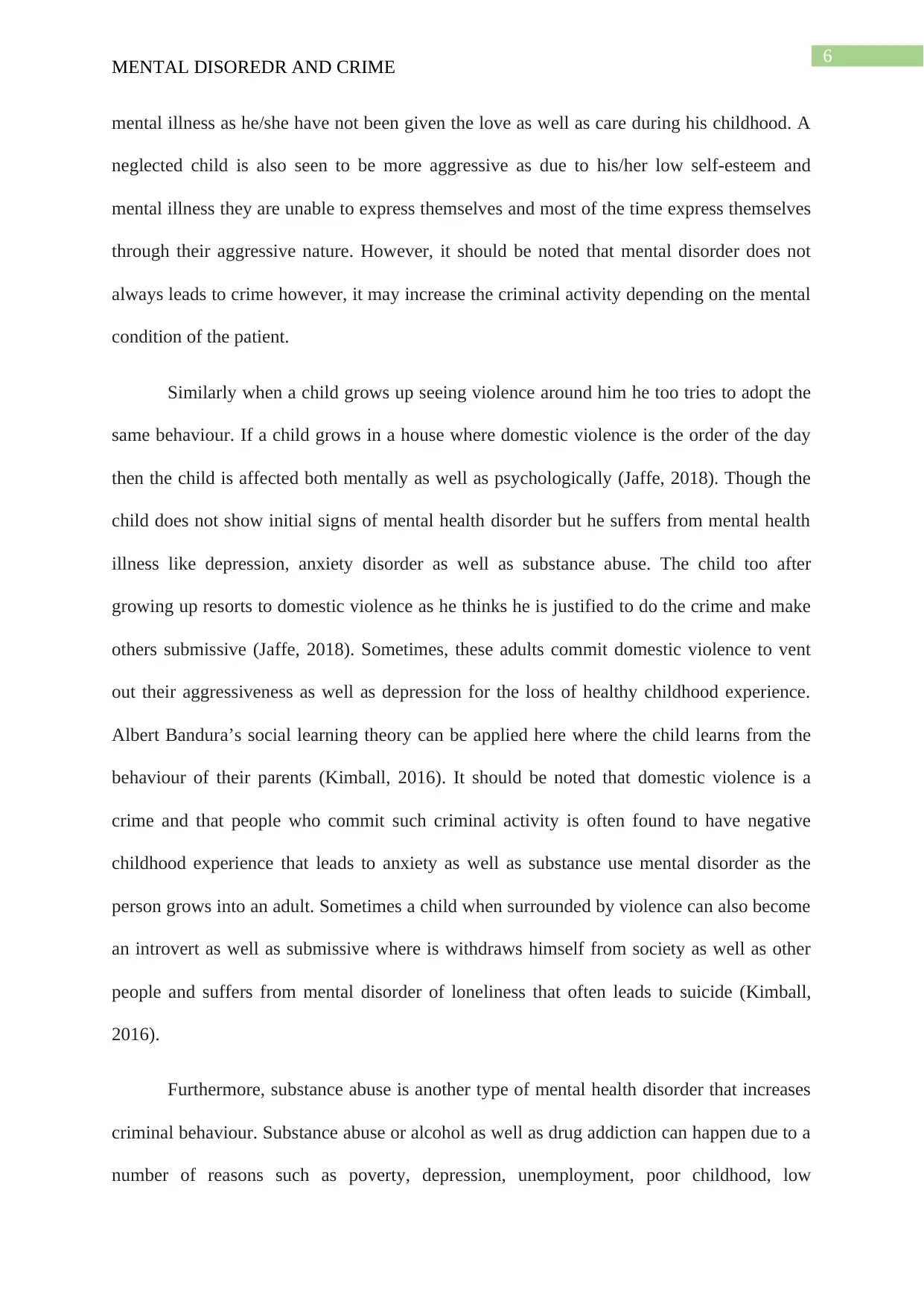
6
MENTAL DISOREDR AND CRIME
mental illness as he/she have not been given the love as well as care during his childhood. A
neglected child is also seen to be more aggressive as due to his/her low self-esteem and
mental illness they are unable to express themselves and most of the time express themselves
through their aggressive nature. However, it should be noted that mental disorder does not
always leads to crime however, it may increase the criminal activity depending on the mental
condition of the patient.
Similarly when a child grows up seeing violence around him he too tries to adopt the
same behaviour. If a child grows in a house where domestic violence is the order of the day
then the child is affected both mentally as well as psychologically (Jaffe, 2018). Though the
child does not show initial signs of mental health disorder but he suffers from mental health
illness like depression, anxiety disorder as well as substance abuse. The child too after
growing up resorts to domestic violence as he thinks he is justified to do the crime and make
others submissive (Jaffe, 2018). Sometimes, these adults commit domestic violence to vent
out their aggressiveness as well as depression for the loss of healthy childhood experience.
Albert Bandura’s social learning theory can be applied here where the child learns from the
behaviour of their parents (Kimball, 2016). It should be noted that domestic violence is a
crime and that people who commit such criminal activity is often found to have negative
childhood experience that leads to anxiety as well as substance use mental disorder as the
person grows into an adult. Sometimes a child when surrounded by violence can also become
an introvert as well as submissive where is withdraws himself from society as well as other
people and suffers from mental disorder of loneliness that often leads to suicide (Kimball,
2016).
Furthermore, substance abuse is another type of mental health disorder that increases
criminal behaviour. Substance abuse or alcohol as well as drug addiction can happen due to a
number of reasons such as poverty, depression, unemployment, poor childhood, low
MENTAL DISOREDR AND CRIME
mental illness as he/she have not been given the love as well as care during his childhood. A
neglected child is also seen to be more aggressive as due to his/her low self-esteem and
mental illness they are unable to express themselves and most of the time express themselves
through their aggressive nature. However, it should be noted that mental disorder does not
always leads to crime however, it may increase the criminal activity depending on the mental
condition of the patient.
Similarly when a child grows up seeing violence around him he too tries to adopt the
same behaviour. If a child grows in a house where domestic violence is the order of the day
then the child is affected both mentally as well as psychologically (Jaffe, 2018). Though the
child does not show initial signs of mental health disorder but he suffers from mental health
illness like depression, anxiety disorder as well as substance abuse. The child too after
growing up resorts to domestic violence as he thinks he is justified to do the crime and make
others submissive (Jaffe, 2018). Sometimes, these adults commit domestic violence to vent
out their aggressiveness as well as depression for the loss of healthy childhood experience.
Albert Bandura’s social learning theory can be applied here where the child learns from the
behaviour of their parents (Kimball, 2016). It should be noted that domestic violence is a
crime and that people who commit such criminal activity is often found to have negative
childhood experience that leads to anxiety as well as substance use mental disorder as the
person grows into an adult. Sometimes a child when surrounded by violence can also become
an introvert as well as submissive where is withdraws himself from society as well as other
people and suffers from mental disorder of loneliness that often leads to suicide (Kimball,
2016).
Furthermore, substance abuse is another type of mental health disorder that increases
criminal behaviour. Substance abuse or alcohol as well as drug addiction can happen due to a
number of reasons such as poverty, depression, unemployment, poor childhood, low
Paraphrase This Document
Need a fresh take? Get an instant paraphrase of this document with our AI Paraphraser
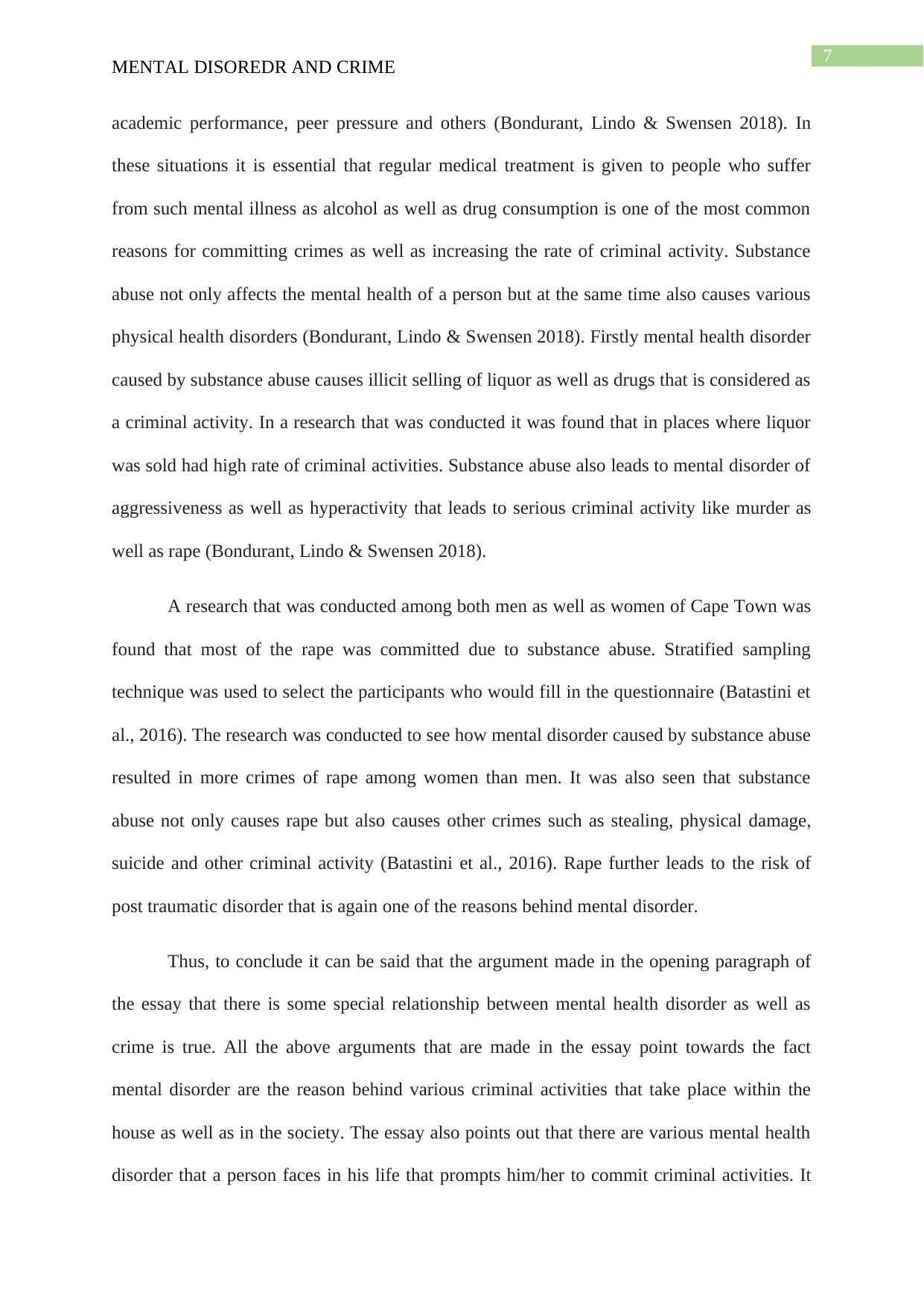
7
MENTAL DISOREDR AND CRIME
academic performance, peer pressure and others (Bondurant, Lindo & Swensen 2018). In
these situations it is essential that regular medical treatment is given to people who suffer
from such mental illness as alcohol as well as drug consumption is one of the most common
reasons for committing crimes as well as increasing the rate of criminal activity. Substance
abuse not only affects the mental health of a person but at the same time also causes various
physical health disorders (Bondurant, Lindo & Swensen 2018). Firstly mental health disorder
caused by substance abuse causes illicit selling of liquor as well as drugs that is considered as
a criminal activity. In a research that was conducted it was found that in places where liquor
was sold had high rate of criminal activities. Substance abuse also leads to mental disorder of
aggressiveness as well as hyperactivity that leads to serious criminal activity like murder as
well as rape (Bondurant, Lindo & Swensen 2018).
A research that was conducted among both men as well as women of Cape Town was
found that most of the rape was committed due to substance abuse. Stratified sampling
technique was used to select the participants who would fill in the questionnaire (Batastini et
al., 2016). The research was conducted to see how mental disorder caused by substance abuse
resulted in more crimes of rape among women than men. It was also seen that substance
abuse not only causes rape but also causes other crimes such as stealing, physical damage,
suicide and other criminal activity (Batastini et al., 2016). Rape further leads to the risk of
post traumatic disorder that is again one of the reasons behind mental disorder.
Thus, to conclude it can be said that the argument made in the opening paragraph of
the essay that there is some special relationship between mental health disorder as well as
crime is true. All the above arguments that are made in the essay point towards the fact
mental disorder are the reason behind various criminal activities that take place within the
house as well as in the society. The essay also points out that there are various mental health
disorder that a person faces in his life that prompts him/her to commit criminal activities. It
MENTAL DISOREDR AND CRIME
academic performance, peer pressure and others (Bondurant, Lindo & Swensen 2018). In
these situations it is essential that regular medical treatment is given to people who suffer
from such mental illness as alcohol as well as drug consumption is one of the most common
reasons for committing crimes as well as increasing the rate of criminal activity. Substance
abuse not only affects the mental health of a person but at the same time also causes various
physical health disorders (Bondurant, Lindo & Swensen 2018). Firstly mental health disorder
caused by substance abuse causes illicit selling of liquor as well as drugs that is considered as
a criminal activity. In a research that was conducted it was found that in places where liquor
was sold had high rate of criminal activities. Substance abuse also leads to mental disorder of
aggressiveness as well as hyperactivity that leads to serious criminal activity like murder as
well as rape (Bondurant, Lindo & Swensen 2018).
A research that was conducted among both men as well as women of Cape Town was
found that most of the rape was committed due to substance abuse. Stratified sampling
technique was used to select the participants who would fill in the questionnaire (Batastini et
al., 2016). The research was conducted to see how mental disorder caused by substance abuse
resulted in more crimes of rape among women than men. It was also seen that substance
abuse not only causes rape but also causes other crimes such as stealing, physical damage,
suicide and other criminal activity (Batastini et al., 2016). Rape further leads to the risk of
post traumatic disorder that is again one of the reasons behind mental disorder.
Thus, to conclude it can be said that the argument made in the opening paragraph of
the essay that there is some special relationship between mental health disorder as well as
crime is true. All the above arguments that are made in the essay point towards the fact
mental disorder are the reason behind various criminal activities that take place within the
house as well as in the society. The essay also points out that there are various mental health
disorder that a person faces in his life that prompts him/her to commit criminal activities. It
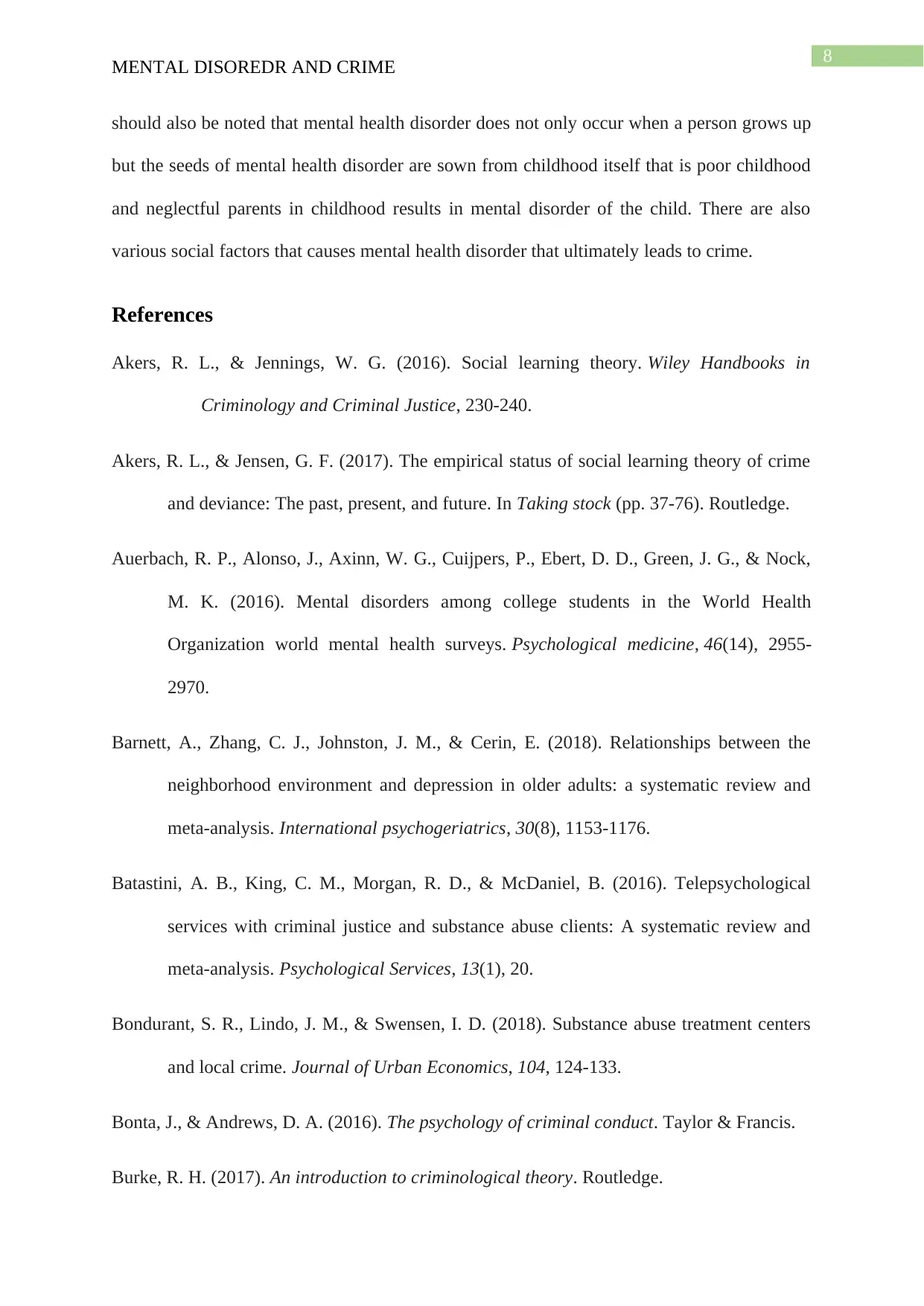
8
MENTAL DISOREDR AND CRIME
should also be noted that mental health disorder does not only occur when a person grows up
but the seeds of mental health disorder are sown from childhood itself that is poor childhood
and neglectful parents in childhood results in mental disorder of the child. There are also
various social factors that causes mental health disorder that ultimately leads to crime.
References
Akers, R. L., & Jennings, W. G. (2016). Social learning theory. Wiley Handbooks in
Criminology and Criminal Justice, 230-240.
Akers, R. L., & Jensen, G. F. (2017). The empirical status of social learning theory of crime
and deviance: The past, present, and future. In Taking stock (pp. 37-76). Routledge.
Auerbach, R. P., Alonso, J., Axinn, W. G., Cuijpers, P., Ebert, D. D., Green, J. G., & Nock,
M. K. (2016). Mental disorders among college students in the World Health
Organization world mental health surveys. Psychological medicine, 46(14), 2955-
2970.
Barnett, A., Zhang, C. J., Johnston, J. M., & Cerin, E. (2018). Relationships between the
neighborhood environment and depression in older adults: a systematic review and
meta-analysis. International psychogeriatrics, 30(8), 1153-1176.
Batastini, A. B., King, C. M., Morgan, R. D., & McDaniel, B. (2016). Telepsychological
services with criminal justice and substance abuse clients: A systematic review and
meta-analysis. Psychological Services, 13(1), 20.
Bondurant, S. R., Lindo, J. M., & Swensen, I. D. (2018). Substance abuse treatment centers
and local crime. Journal of Urban Economics, 104, 124-133.
Bonta, J., & Andrews, D. A. (2016). The psychology of criminal conduct. Taylor & Francis.
Burke, R. H. (2017). An introduction to criminological theory. Routledge.
MENTAL DISOREDR AND CRIME
should also be noted that mental health disorder does not only occur when a person grows up
but the seeds of mental health disorder are sown from childhood itself that is poor childhood
and neglectful parents in childhood results in mental disorder of the child. There are also
various social factors that causes mental health disorder that ultimately leads to crime.
References
Akers, R. L., & Jennings, W. G. (2016). Social learning theory. Wiley Handbooks in
Criminology and Criminal Justice, 230-240.
Akers, R. L., & Jensen, G. F. (2017). The empirical status of social learning theory of crime
and deviance: The past, present, and future. In Taking stock (pp. 37-76). Routledge.
Auerbach, R. P., Alonso, J., Axinn, W. G., Cuijpers, P., Ebert, D. D., Green, J. G., & Nock,
M. K. (2016). Mental disorders among college students in the World Health
Organization world mental health surveys. Psychological medicine, 46(14), 2955-
2970.
Barnett, A., Zhang, C. J., Johnston, J. M., & Cerin, E. (2018). Relationships between the
neighborhood environment and depression in older adults: a systematic review and
meta-analysis. International psychogeriatrics, 30(8), 1153-1176.
Batastini, A. B., King, C. M., Morgan, R. D., & McDaniel, B. (2016). Telepsychological
services with criminal justice and substance abuse clients: A systematic review and
meta-analysis. Psychological Services, 13(1), 20.
Bondurant, S. R., Lindo, J. M., & Swensen, I. D. (2018). Substance abuse treatment centers
and local crime. Journal of Urban Economics, 104, 124-133.
Bonta, J., & Andrews, D. A. (2016). The psychology of criminal conduct. Taylor & Francis.
Burke, R. H. (2017). An introduction to criminological theory. Routledge.
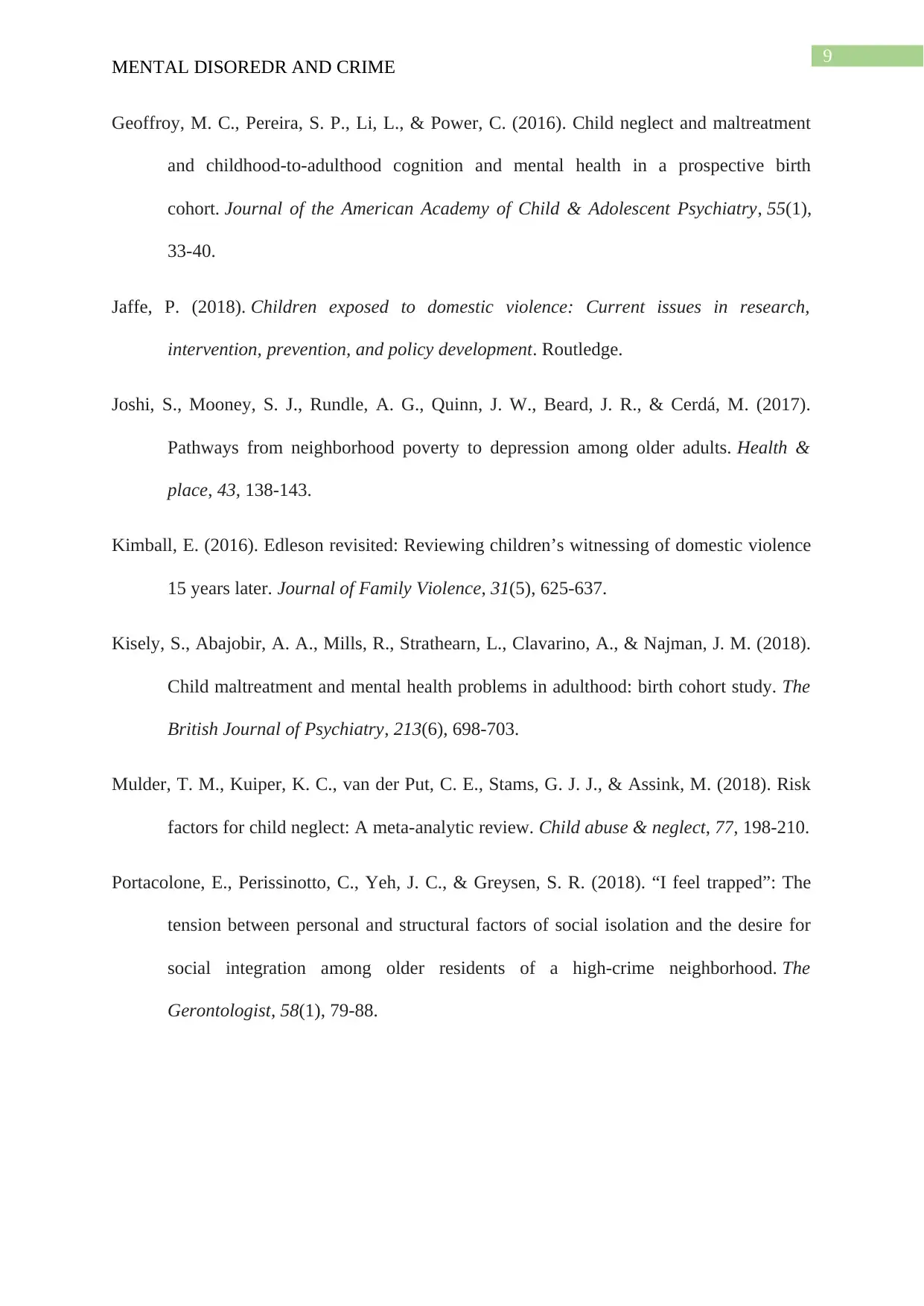
9
MENTAL DISOREDR AND CRIME
Geoffroy, M. C., Pereira, S. P., Li, L., & Power, C. (2016). Child neglect and maltreatment
and childhood-to-adulthood cognition and mental health in a prospective birth
cohort. Journal of the American Academy of Child & Adolescent Psychiatry, 55(1),
33-40.
Jaffe, P. (2018). Children exposed to domestic violence: Current issues in research,
intervention, prevention, and policy development. Routledge.
Joshi, S., Mooney, S. J., Rundle, A. G., Quinn, J. W., Beard, J. R., & Cerdá, M. (2017).
Pathways from neighborhood poverty to depression among older adults. Health &
place, 43, 138-143.
Kimball, E. (2016). Edleson revisited: Reviewing children’s witnessing of domestic violence
15 years later. Journal of Family Violence, 31(5), 625-637.
Kisely, S., Abajobir, A. A., Mills, R., Strathearn, L., Clavarino, A., & Najman, J. M. (2018).
Child maltreatment and mental health problems in adulthood: birth cohort study. The
British Journal of Psychiatry, 213(6), 698-703.
Mulder, T. M., Kuiper, K. C., van der Put, C. E., Stams, G. J. J., & Assink, M. (2018). Risk
factors for child neglect: A meta-analytic review. Child abuse & neglect, 77, 198-210.
Portacolone, E., Perissinotto, C., Yeh, J. C., & Greysen, S. R. (2018). “I feel trapped”: The
tension between personal and structural factors of social isolation and the desire for
social integration among older residents of a high-crime neighborhood. The
Gerontologist, 58(1), 79-88.
MENTAL DISOREDR AND CRIME
Geoffroy, M. C., Pereira, S. P., Li, L., & Power, C. (2016). Child neglect and maltreatment
and childhood-to-adulthood cognition and mental health in a prospective birth
cohort. Journal of the American Academy of Child & Adolescent Psychiatry, 55(1),
33-40.
Jaffe, P. (2018). Children exposed to domestic violence: Current issues in research,
intervention, prevention, and policy development. Routledge.
Joshi, S., Mooney, S. J., Rundle, A. G., Quinn, J. W., Beard, J. R., & Cerdá, M. (2017).
Pathways from neighborhood poverty to depression among older adults. Health &
place, 43, 138-143.
Kimball, E. (2016). Edleson revisited: Reviewing children’s witnessing of domestic violence
15 years later. Journal of Family Violence, 31(5), 625-637.
Kisely, S., Abajobir, A. A., Mills, R., Strathearn, L., Clavarino, A., & Najman, J. M. (2018).
Child maltreatment and mental health problems in adulthood: birth cohort study. The
British Journal of Psychiatry, 213(6), 698-703.
Mulder, T. M., Kuiper, K. C., van der Put, C. E., Stams, G. J. J., & Assink, M. (2018). Risk
factors for child neglect: A meta-analytic review. Child abuse & neglect, 77, 198-210.
Portacolone, E., Perissinotto, C., Yeh, J. C., & Greysen, S. R. (2018). “I feel trapped”: The
tension between personal and structural factors of social isolation and the desire for
social integration among older residents of a high-crime neighborhood. The
Gerontologist, 58(1), 79-88.
Secure Best Marks with AI Grader
Need help grading? Try our AI Grader for instant feedback on your assignments.
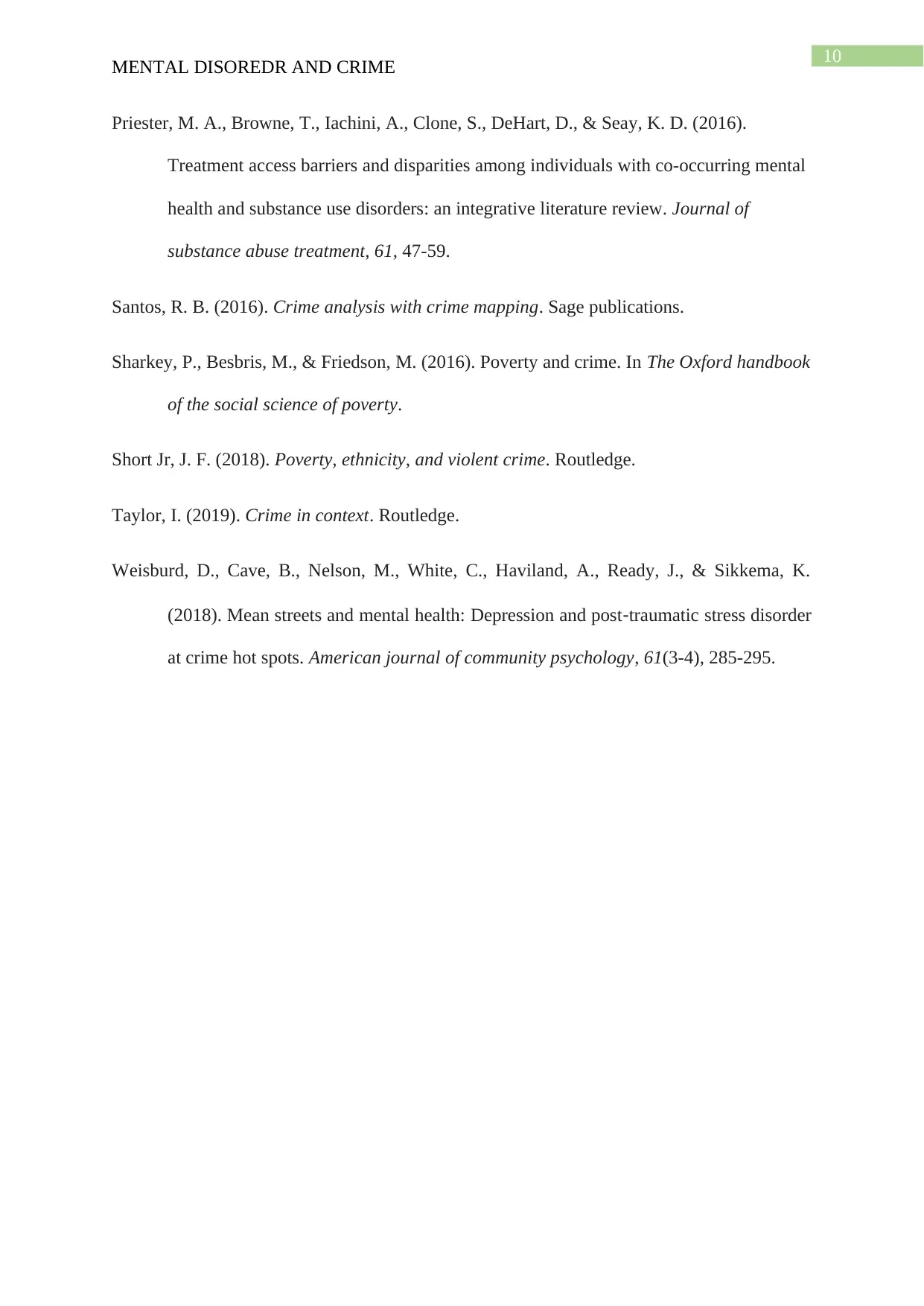
10
MENTAL DISOREDR AND CRIME
Priester, M. A., Browne, T., Iachini, A., Clone, S., DeHart, D., & Seay, K. D. (2016).
Treatment access barriers and disparities among individuals with co-occurring mental
health and substance use disorders: an integrative literature review. Journal of
substance abuse treatment, 61, 47-59.
Santos, R. B. (2016). Crime analysis with crime mapping. Sage publications.
Sharkey, P., Besbris, M., & Friedson, M. (2016). Poverty and crime. In The Oxford handbook
of the social science of poverty.
Short Jr, J. F. (2018). Poverty, ethnicity, and violent crime. Routledge.
Taylor, I. (2019). Crime in context. Routledge.
Weisburd, D., Cave, B., Nelson, M., White, C., Haviland, A., Ready, J., & Sikkema, K.
(2018). Mean streets and mental health: Depression and post‐traumatic stress disorder
at crime hot spots. American journal of community psychology, 61(3-4), 285-295.
MENTAL DISOREDR AND CRIME
Priester, M. A., Browne, T., Iachini, A., Clone, S., DeHart, D., & Seay, K. D. (2016).
Treatment access barriers and disparities among individuals with co-occurring mental
health and substance use disorders: an integrative literature review. Journal of
substance abuse treatment, 61, 47-59.
Santos, R. B. (2016). Crime analysis with crime mapping. Sage publications.
Sharkey, P., Besbris, M., & Friedson, M. (2016). Poverty and crime. In The Oxford handbook
of the social science of poverty.
Short Jr, J. F. (2018). Poverty, ethnicity, and violent crime. Routledge.
Taylor, I. (2019). Crime in context. Routledge.
Weisburd, D., Cave, B., Nelson, M., White, C., Haviland, A., Ready, J., & Sikkema, K.
(2018). Mean streets and mental health: Depression and post‐traumatic stress disorder
at crime hot spots. American journal of community psychology, 61(3-4), 285-295.
1 out of 11
Related Documents
Your All-in-One AI-Powered Toolkit for Academic Success.
+13062052269
info@desklib.com
Available 24*7 on WhatsApp / Email
![[object Object]](/_next/static/media/star-bottom.7253800d.svg)
Unlock your academic potential
© 2024 | Zucol Services PVT LTD | All rights reserved.





